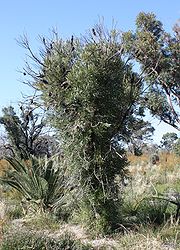
Resprouter
Encyclopedia

Fire
Fire is the rapid oxidation of a material in the chemical process of combustion, releasing heat, light, and various reaction products. Slower oxidative processes like rusting or digestion are not included by this definition....
by the activation of dormant vegetative bud
Bud
In botany, a bud is an undeveloped or embryonic shoot and normally occurs in the axil of a leaf or at the tip of the stem. Once formed, a bud may remain for some time in a dormant condition, or it may form a shoot immediately. Buds may be specialized to develop flowers or short shoots, or may have...
s to produce regrowth.
Plants may resprout by means of lignotuber
Lignotuber
A lignotuber is a starchy swelling of the root crown possessed by some plants as a protection against destruction of the plant stem by fire. The crown contains buds from which new stems may sprout, and a sufficient store of nutrients to support a period of growth in the absence of...
s at the base or epicormic buds on the trunk or major branches.
Resprouters characterize chaparral
Chaparral
Chaparral is a shrubland or heathland plant community found primarily in the U.S. state of California and in the northern portion of the Baja California peninsula, Mexico...
, fynbos
Fynbos
Fynbos is the natural shrubland or heathland vegetation occurring in a small belt of the Western Cape of South Africa, mainly in winter rainfall coastal and mountainous areas with a Mediterranean climate...
, kwongan
Kwongan
Kwongan is a type of heathland found on the coastal plains of Western Australia. The name is derived from the language of the Noongar people. Kwongan comprises floristically-rich heath with dense thickets of sclerophyllous shrubs and isolated small trees...
, savanna
Savanna
A savanna, or savannah, is a grassland ecosystem characterized by the trees being sufficiently small or widely spaced so that the canopy does not close. The open canopy allows sufficient light to reach the ground to support an unbroken herbaceous layer consisting primarily of C4 grasses.Some...
and other landscapes that experience periodic fires.
See also
- Adventitiousness
- CoppicingCoppicingCoppicing is a traditional method of woodland management which takes advantage of the fact that many trees make new growth from the stump or roots if cut down. In a coppiced wood, young tree stems are repeatedly cut down to near ground level...
- Crown sproutingCrown sproutingCrown sprouting is the ability of a plant to regenerate its shoot system after destruction by activating dormant vegetative structures to produce regrowth from the root crown . These dormant structures take the form of lignotubers or basal epicormic buds...
- Cutting (plant)
- Epicormic shootEpicormic shootAn epicormic shoot is a shoot growing from an epicormic bud which lies underneath the bark of a trunk, stem, or branch of a plant.-Epicormic buds:...
- Water sproutWater sproutWater sprouts are shoots that arise from the trunk of a tree or from branches that are several years old, from latent buds. The latent buds might be visible on the bark of the tree, or submerged under the bark as epicormic buds. They are sometimes called suckers, although that term is more...

